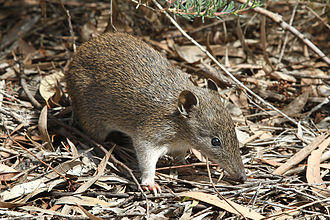Plight of the bandicoot in prime-time spotlight
 Channel 9's Saturday night newsÌýfeatured theÌý an endangered species with populations across the Adelaide Hils and Mount Lofty Ranges.
Channel 9's Saturday night newsÌýfeatured theÌý an endangered species with populations across the Adelaide Hils and Mount Lofty Ranges.Habitat preservation is key to the survival of the bandicoot.ÌýBut the habitat of this native marsupialÌýposes a problem to both residents of the Adelaide Hills and conservationists. Bandicoots thrive around private homes and gardens, and surprisingly, amongst invasive non-native species.
The Environment Institute, the (DEWNR) and the (PIRSA) have been working collaboratively on research that shows that bandicoots depend upon the non-native blackberry shrub for food and shelter.ÌýHowever, the blackberry has been listed as invasive pest in the Adelaide Hills region.
The research wasÌý,Ìýled byÌý.
Recently, proposals have been put forth to clear land in the Adelaide Hills region,Ìýremoving vital vegetation for the bandicoot.ÌýEfforts to protect the bandicoot have been bolstered by support from theÌýÌý(³§±«¸é³¢³Ò).
The future of bandicoot survival is further threatened by the creature’s inability to find mates in distant locations. Our research, led by Professor Steven Cooper, , uncovered the need for genetic diversity to sustain future populations. An ongoing proposal for a aims to address this concern. The proposed tunnel would cross underneath Upper Sturt Road to connect bandicoot populations in Belair National Park and Mark Oliphant Conservation Park, thereby facilitating breeding.
The news segment appeared on Channel 9 on 29 October, 2016

Newsletter & social media
Join us for a sensational mix of news, events and research at the Environment Institute. Find out aboutÌýnew initiatives andÌýshare with your friends what's happening.
ÌýÌýÌý
